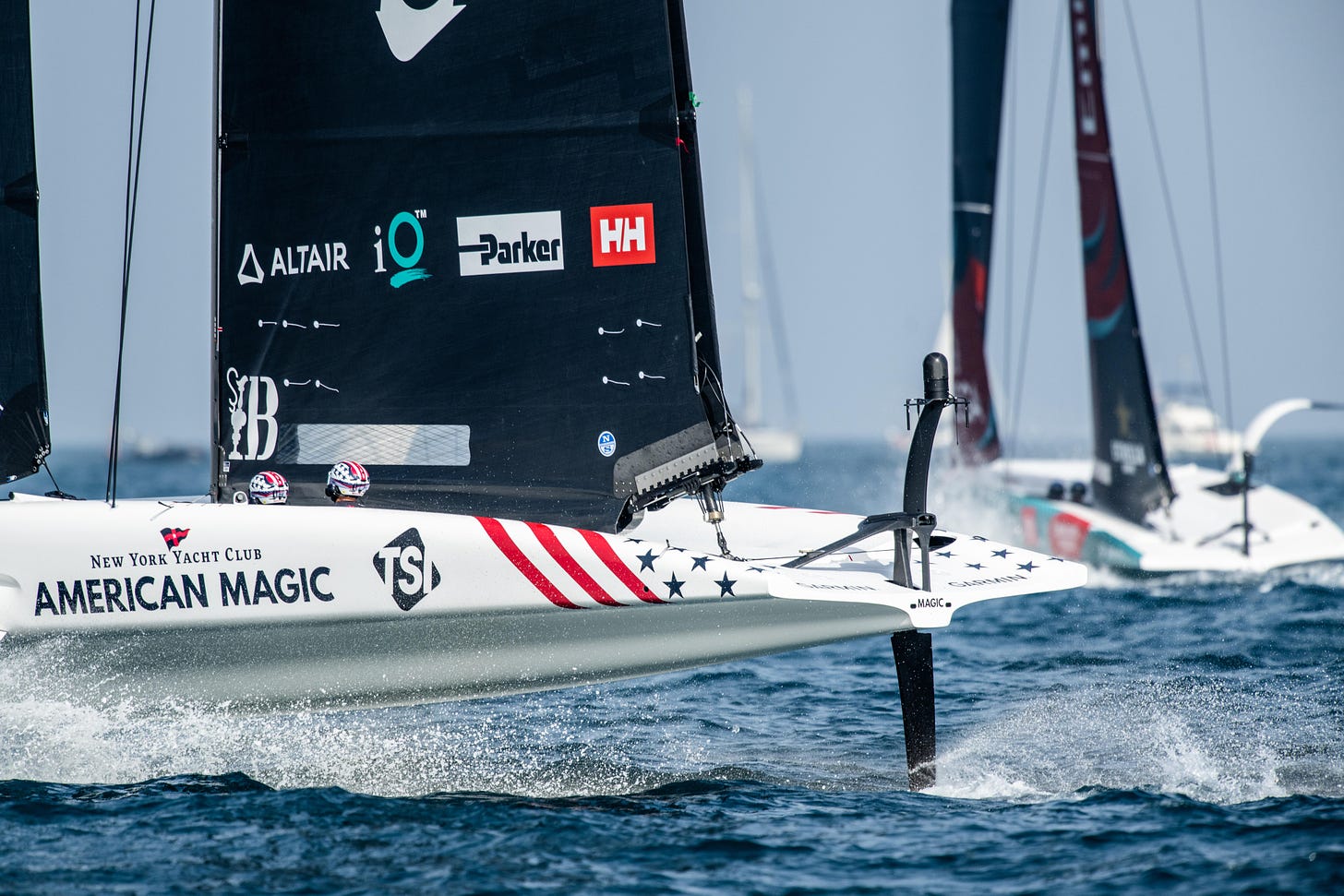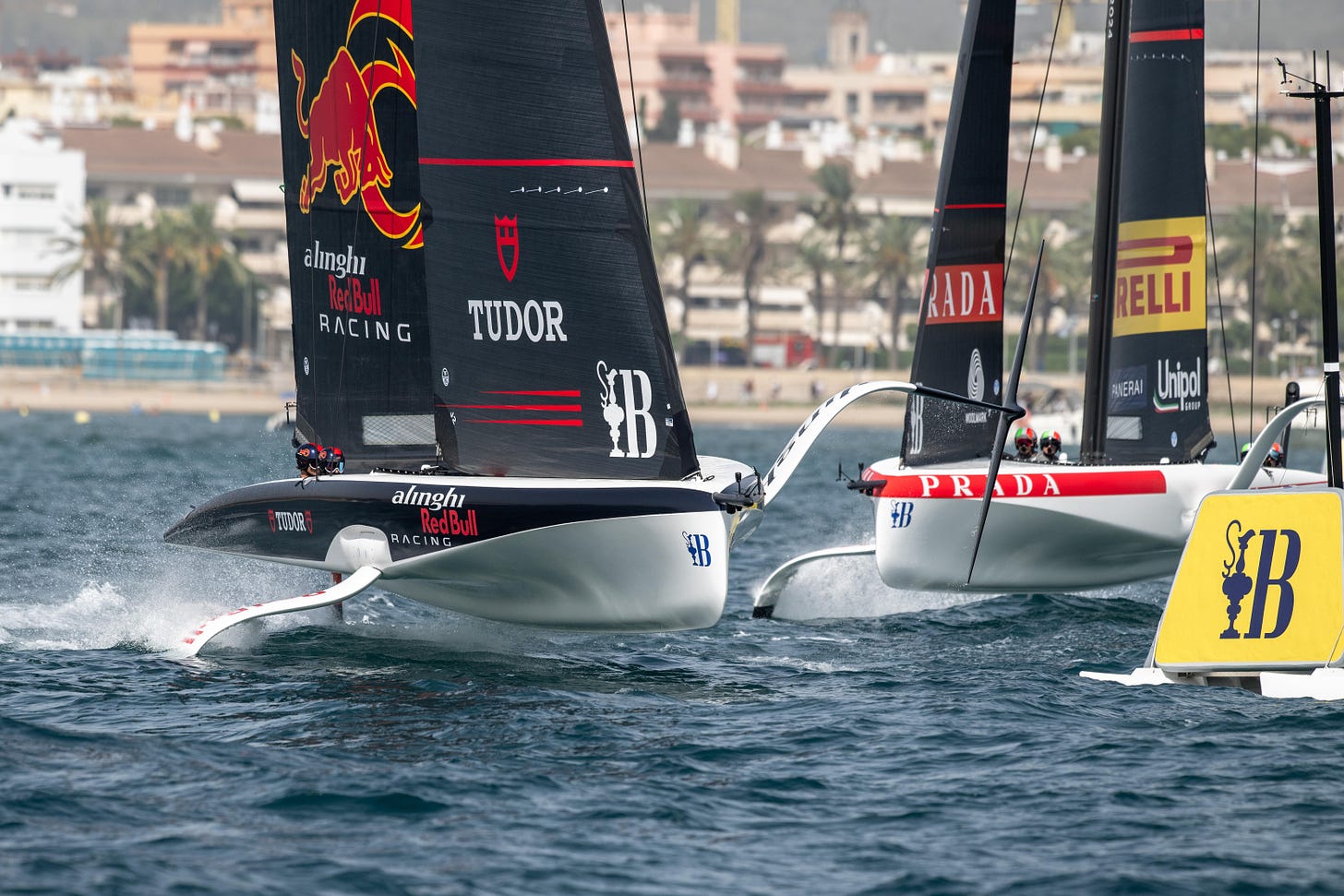Vilanova i la Geltrú review
My thoughts on the first preliminary regatta of the 37th America’s Cup cycle that took place over the past weekend in the Spanish city of Vilanova i la Geltrú
What to say about the first preliminary regatta of the 37th America’s Cup cycle that took place over the past weekend in the Spanish city of Vilanova i la Geltrú?
The first and most obvious comment is that the weather gods appeared to be actively conspiring against any meaningful racing for the first two days of the event.
Friday saw thunderstorms and rain of biblical proportions deluge the city, forcing race director Iain Murray to bring the fleet ashore without any action. Saturday brought sunnier, drier weather but only a light, fitful breeze that made foiling near impossible during the two races held.
Happily for all concerned, the gods grudgingly relented on Sunday enabling three exciting fleet races to be conducted in warm sunshine and 8 to 10 knots of breeze. That said, there was no final cherry on the cake for the organisers after a virtual glassout late in the day meant the final match race between NYYC American Magic and Emirates Team New Zealand could not be staged.
Despite all the weather-related setbacks, from my perspective, there are plenty of positives to be taken from this opening America’s Cup event.
First and foremost is that, in the right breeze, AC40 fleet racing is a stunning spectacle. Watching the world’s best foiling protagonists – the likes of Tom Slingsby, Paul Goodison, Peter Burling, Nathan Outteridge, et al – going at it in identical fast and nimble one-designs is simply superb to watch.
Seeing the six teams power off the line in the first of Sunday’s three races really was a sight to behold. Out on the racetrack the margins were ultra-tight with any minor boathanding slip-up cruelly punished. There were constant place changes throughout Sunday’s action and the final standings were in doubt until the final leg of the last fleet race. What more can you ask for?
A word here about the naysayers who think the foiling era of the America’s Cup to be an abomination.
For the record, I have no argument with the complaint that helmeted and visored sailors sitting in cramped cockpits, using race car steering wheels and pressing buttons rather than pulling ropes makes the racing less relatable to the mainstream sailing audience.
But if you can get past all that and look a little deeper into how this new generation of America’s Cup sailors are sailing these remarkable boats, you will find lots in common with what the naysayers call ‘proper sailing’.
They may not be running around the deck of their boats pulling sails up and down and manhandling spinnaker poles like the rest of us do, but they are still looking for gusts, lulls, and shifts in the wind and changing the trim of their sails accordingly.
They are still thinking about tactics and strategy, how best to deal with boat on boat situations, and how to make the smoothest rounding of the leeward and windward marks.
Listening to the onboard communications from the boats over the weekend confirmed all of this. The cool, calm, clinical, way that the sailors conversed with each other whether things were going well or badly is an object lesson in how to communicate while racing on any boat.
While on that subject, kudos to the America’s Cup commentary team – anchorman Stephen McIver, along with sailing experts Peter Lester, Hannah Mills, and Glenn Ashby – for leaving enough space for us to be able to hear what was being said on board. That’s a refreshing change from the breathless, no pauses, delivery of SailGP.
Much has already been written about Saturday’s (mostly) no foiling races with many bemoaning the dullness of watching foiling boats racing in light winds.
I fundamentally get where they are coming from but, actually, I quite enjoyed watching the final leg of the first race on Saturday as the French and the Italians duked at six knots it out as they trickled their way downwind towards the finish line.
I’m not just saying that to take a contrary position – I really did find the way the sailors instantly switched from high-speed foiling mode to eking out every fraction of a knot they could from their boats.
Thinking about it, shouldn’t the traditionalists have loved it? The boats were all going sub-10 knots and the sailors were moving around on deck, some crouching on the foredeck holding the clew of the jib out, and some scanning the racecourse for the next zephyr. Sounds a lot like ‘proper sailing’ to me.
Nevertheless, like most people I breathed a sigh of relief when the breeze arrived for Sunday’s final day of racing. Out on the water it was surprisingly bumpy given the relatively low wind strength and aside from this chop there was a bit of swell that seemed slightly out of kilter with the wind direction.
With a satisfyingly large spectator fleet encircling the course, two TV helicopters roaring overhead, as well as the team’s chase boats and other ancillary support vessels buzzing around, there was no shortage of atmosphere. Likewise, from what I could see, the beach viewing zone was packed to capacity too. All in all it felt like Vilanova i la Geltrú and the surrounding area had fully embraced Spain’s first America’s Cup event since the 33nd edition in Valencia in 2010.
Going into the final day my bold prediction last week of the Americans emerging triumphant from a match race with New Zealand was looking more than a little shaky.
The Kiwis – who had looked a cut above the rest when there had been any breeze on Saturday – were top of the table, while NYYC American Magic were languishing in fifth place and eight points adrift.
My pick turned things around though, with helmsmen Tom Slingsby and Paul Goodison spearheading a remarkable comeback by way of a 2,1,1 scoreline that saw them top the leaderboard after five races sailed.
I predicted last week that the Americans might have more to prove than the Kiwis and it certainly seemed like they had plenty of fire in their bellies on that final day.
The first race of the day saw the Kiwis in control from the first beat and able to extend away as the second placed Americans had to defend throughout from the Italian Luna Rossa Prada Pirelli squad as well as the Swiss Alinghi Red Bull Racing team.
American Magic took control at the start of the next race, shutting out Emirates Team New Zealand at the windward end of the line before leading the fleet away from the middle of the line. This left the New Zealand forced to tack away early to the right and when they reconnected with the pack in the final third of the beat the Italians delivered them a brutal slam dunk cover tack from which they never recovered to finish fourth. Meanwhile the Americans sailed to a runaway victory that put them second place – two points behind the Kiwis.
[It’s worth noting here the unusual scoring system used in the America’s Cup for fleet racing that significantly rewards a podium placing with 10 points for a race win, seven for second, five for third. Fourth scores three points, fifth gets two points, with one point going to sixth.]
By the third and final fleet race of the day NYYC American Magic had the bit well and truly between their teeth. The top two pairing were the only ones to start on starboard with the Kiwis getting away cleanest with a boat length’s lead towards the leeward end of the line.
At the first windward gate the Kiwis led the fleet and looked to be in complete control, until a fluffed gybe in the last third of the final downwind leg handed the lead to the Americans. From that point the US crew didn’t put a foot wrong and cruised home to take the victory and the 10 points that put them one point ahead of New Zealand who had fought back to second.
With not enough wind for the final match race to be concluded the regatta victory was awarded to NYYC American Magic, with Emirates Team New Zealand in second, the French Orient Express Racing Team in third, Italy’s Luna Rossa Prada Pirelli Team in fourth, the Swiss Alinghi Red Bull Racing in fifth, and the British INEOS Britannia in sixth.
Happiest of all the teams this week of course will be the American winners who proved they had the talent and the metal to claw themselves back to the top of the table on the final day.
Also happy with their third place performance will be the French who were expected to be back markers after only taking delivery of their AC40 a few weeks previously. Quentin Delapierre’s crew took their chances when they came in the light winds and when the breeze was up they proved well capable of mixing it at the front of the fleet.
Likewise the Swiss who looked impressive all weekend and will feel cheated of their chance of a tilt at a podium spot which evaporated when a hydraulic issue prevented them from starting the final race.
For Emirates Team New Zealand it must feel like a regatta win that slipped from their grasp. While imperious and dominating at times during the weekend they know they faltered when it matters with uncharacteristic boathanding mistakes that cost them dearly.
The Italians meanwhile must be ruing the chances that got away over this regatta and resulted in a 2,6,3,3,5 scoreline that put them down in fourth overall, well adrift of a podium spot.
That just leaves the British team who by their own high standards had a shocker of a regatta. A lack of focus on the AC40 is the obvious reason for this lacklustre performance and the team has declared its intention to put that right before the next event.
All in all a good first event for the organisers who are already working hard on the second preliminary regatta in Jeddah, Saudi Arabia at the end of November.
Justin











Justin…You are correct in thinking that those moments of soft breeze and tip toeing on the deck to hand shape the sails are ‘traditional sailing’…
But I also think the whole foiling era is as well, at least as compared with traditional ice boating. It is the thinking and learning about core sailing and its consistency with high speed that is exciting to me. The core science is the same, through a fast matrix. I could not believe it when I first saw the dual layer mainsail on American Magic (the airborne) …I had imagined that sail one day years ago in a light air race and thinking if ’I only had one to adjust’…it would have been great.
Great positive report. Have the same thoughts and having been a Moth sailor being able to score in the light (Displacement mode) but not in the windy Garda, I fully understood the drama and could feel with the teams. Interesting and exciting races.